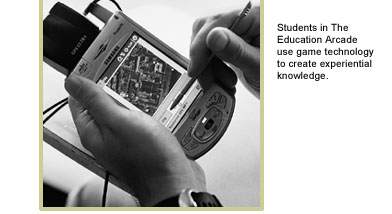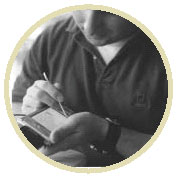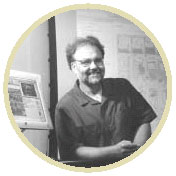|
|
||||

As students returned to MIT this fall, many undergraduates noticed a new course choice in the 2003ö2004 syllabus. Comparative Media Studies (CMS) has joined the ranks of approved majors at MIT as "Course 21"—the first interdisciplinary major offered at the Institute. This exciting development underscores the rapid evolution of a program that was started by Professor of Literature David Thorburn only twenty years ago as "Film and Media Studies," and which became a graduate discipline as recently as 1998. It also recognizes the success of that program: more and more students have been declaring CMS as a major in the past several years, in numbers comparable to those choosing more established programs. The new CMS major is also part of a larger intellectual landscape, in which new kinds of knowledge are breaking down the boundaries among previously distinct disciplines. In fact, according to Henry Jenkins III—John E. Burchard Professor of Humanities, and director of the Comparative Media Studies program—this is one reason why establishing the CMS major has been an uphill struggle. As his colleague David Thorburn was leading CMS through the application process to establish a new undergraduate major, MIT policies dealing with interdisciplinary majors were still in the process of being established.
As a result, explains Jenkins, Thorburn's first several attempts were unsuccessful. "Everybody liked what we were doing, and was excited about the program," he recalls. "But the Institute was determined to establish policies that would be appropriately selective about which majors were approved. MIT didn't want a proliferation of new interdisciplinary majors, just because they were trendy. MIT wanted substance." In that sense, the CMS major turned out to be a natural fit for MIT. Professor of Comparative Media Studies William Uricchio—who joined the program in 2000, and is Acting Director while Professor Jenkins is on leave this fall—points out that conceptually, the program maps very well onto MIT's structure. "At MIT," he says, "people are much more content-oriented than they are concerned with departmental barriers. It's easy to jump over departmental walls in the interests of research. It's a natural fit with MIT's approach to intellectual inquiry." There's a larger benefit for the Institute, as well, Jenkins points out. MIT has long been an acknowledged leader in new media, and to remain so, he says, it must also be a leader in understanding the cultural and social effects of those technologies. To illustrate his point, Jenkins tells the story of an early (and unsuccessful) foray by Thomas Edison into the doll industry: "China dolls were then the industry standard. But the problem with the early china dolls was that their heads broke easily. Edison looked at this technical problem, and came up with a good technical solution: the cast-iron baby doll! "Meanwhile, a cottage industry of start-up toy companies, generally run by women who had inherited the businesses from their fathers or husbands, was also tackling the problem. These companies of necessity had on-site daycare, and were able to test their products on children. They discovered through trial and error that india rubber worked well, and was very popular with the children, who loved the tactile qualities of the material. "Well, the same principle holds true in media studies: if you're designing for people, you're going to design better technologies. Where humanities is able to touch the technical, MIT benefits on a large level." This concept—of the humanities influencing the technical—leads to a precept that Jenkins refers to as "applied humanism," and it is one of the qualities that helps CMS stand out among other top-level media programs across the country. The philosophy was born in 1998, during the establishment of the graduate degree program, when Jenkins and Thorburn—then relatively far along in the program-design process—faced an unusual challenge. A member of a review committee asked them what kind of masters they were interested in offering: a Masters of Art, or of Science? "Because if you're thinking of a Masters of Art," the review board member cautioned, "you'll have to rewrite the charter of MIT." Jenkins and Thorburn had, indeed, been aiming towards an arts degree. Now, faced with this dilemma, they scrambled, did some hard rethinking, and came up with a reconfigured program that incorporated elements of the scientific process into the program. The effects of this reorientation, according to Jenkins, were profound. This was the moment, he says, when the program took a definitive shape. For example: CMS has an unusually strong focus on methodology research, and there's an intensive hands-on requirement, involving media production, for every student. In essence, CMS takes what humanists know and applies that in a pragmatic way to real-world problems. And this emphasis makes the CMS graduates enormously valuable in the job market. As Jenkins explains, "We move from the abstraction of the book to a concrete program, to developing some sort of social intervention, to direct engagement with contemporary media change issues. We don't just study media, and we don't just teach production. We've integrated the two, so that they inform each other." In that spirit, CMS sponsors a wide array of projects in which students work in teams with faculty on innovative experiments with a practical emphasis. Two of the more exciting projects are in the education realm: Metamedia, and The Education Arcade. Metamedia, co-directed by Professor of Literature Peter Donaldson and Dr. Kurt Fendt, focuses on developing web-based information archives that can support courses and subjects by collecting a wide range of material related to the core subject. The project's vision is an increasingly active and participatory learning experience. Currently in its third year, Metamedia was inspired by two projects: The Shakespeare Electronic Archive, built by Donaldson, and Berliner Sehen, a German language program built by Fendt. Both of these projects are essentially frameworks—organized archives of content that allow students to access, interpret, and rearrange primary documents. Building on these models, and drawing upon funding from the D'Arbeloff Fund for Excellence in Education at MIT, Metamedia faculty and students have built a flexible frame that allows other faculty to build similar archives. So far, there are about 15 of these modules, on subjects ranging from foreign languages, to anthropology, to literature. Metamedia has proved to be a helpful classroom tool, and it also has exciting implications for distance learning. "Right now," explains Kurt Fendt, "a lot of the distance-learning models are still based on distribution. We have a different vision—a model based on community. The framework we've built encourages collaboration between students, regardless of distance. It allows for a multidirectional flow of ideas, and an active use of documents." Another unexpected benefit, according to Jenkins, is an improvement in students' writing skills. "A common problem with undergraduates," he says, "is that they tend to be vague, to speak in generalizations in their writing. With the archives, they're forced to draw in concrete material and engage with it. Students are seeing the need to interpret the sources they use, and the result is stronger writing overall." Another CMS-sponsored project is The Education Arcade, managed by CMS graduate Philip Tan. The Education Arcade recognizes the power and pervasiveness of games—a 2001 survey of entering MIT freshman found that every single student had played video games, and a majority preferred them over any other medium—and attempts to harness that technology as a teaching tool. Though not a substitute for classroom learning, game technology has several strengths that lend themselves to teaching—for example, simulation. "If you want to play out a process, and let people see the effects of changing variables," explains Jenkins, "games are incredibly powerful technology." Games also help create experiential, rather than abstract, knowledge. Once students have gone through a game and applied their knowledge to solve a problem, they have a set of real experiences that can help them retrieve that information later. One of the games developed by the The Education Arcade, for example, helps improve students' understanding of electromagnetism. When project managers spoke to John Belcher, of MIT's physics department, they learned that a significant portion of MIT undergraduates were failing the electromagnetism section of the physics exam. Belcher ventured the opinion that this was because electromagnetism works in counterintuitive ways. Based on this insight, Tan and a team of undergraduates designed a game—"Supercharged"—that would put students into a virtual space where they could experience the inner workings of magnetic fields. So far, the game has been a marked success. Based on testing of MIT students and area high school students, it appears that students are not only excited about and motivated by the game-playing, but they also are learning what the game is trying to teach. Other games under development involve history and literature. One example—developed in collaboration with William R. Kenan, Jr. Professor of American History Pauline Maier—is "Revolution," a multi-player game in which students assume the roles of villagers in a small Virginia town on the eve of the American Revolution. Students use original documents to make decisions, and then experience the ramifications of these decisions in a community that is divided into royalists and revolutionaries. Yet another game, "Environmental Detectives," harnesses GPS technology to show students how chemical spills infiltrate groundwater. Teamwork is a mainstay of these projects, and of the larger CMS program. This is due, in large part, to early feedback from the industry. During the process of creating CMS, Jenkins talked to more than 40 media companies to find out what they were looking for in potential employees. "I was told over and over again," he recalls, "that humanities students generally have less leadership experience, and weaker communication, brainstorming, problem-solving, and teamwork skills." The team-based project structure gives students valuable practical experience in building these critical skills. Philip Tan can be considered a case in point. The technical director of Supercharged while still a graduate student, Tan learned so much from that experience that Jenkins and Uricchio have now tapped him to assume management of the entire Education Arcade program. Luckily, Jenkins notes, collaboration comes naturally to CMS's students. "In a liberal arts college," he explains, "if you put an idea on the table, it's like rams butting heads. People want to demonstrate their prowess by knocking someone else down . . . and by the end of a discussion, there's nothing left. At MIT, it's brainstorming. Problem-solving. You put an idea on the table, and students tinker with it, make it better. And at the end of the period, you have something that's more effective at responding to the problem. You've gained ground." CMS both benefits from and reinforces that tradition. "What we've done in CMS," Jenkins concludes, "is to harness that MIT skill, and apply it to the challenges that our culture and society face, and to media change for the 21st century."
|
||||

 Right: Students in The Education Arcade use game technology to create experiential knowledge.
Right: Students in The Education Arcade use game technology to create experiential knowledge.  Left: Dr. Kurt Fendt, co-director of the Metamedia Project, designs web-based information archives to support courses by collecting a wide range of related materials.
Left: Dr. Kurt Fendt, co-director of the Metamedia Project, designs web-based information archives to support courses by collecting a wide range of related materials. Early concept art by Abbi Orenstein
Early concept art by Abbi Orenstein